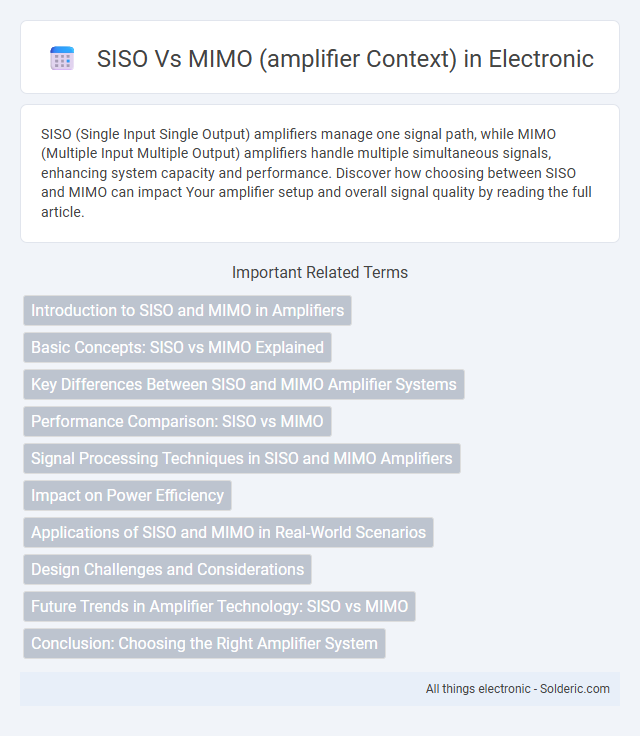SISO (Single Input Single Output) amplifiers manage one signal path, while MIMO (Multiple Input Multiple Output) amplifiers handle multiple simultaneous signals, enhancing system capacity and performance. Discover how choosing between SISO and MIMO can impact Your amplifier setup and overall signal quality by reading the full article.
Comparison Table
| Feature | SISO (Single Input Single Output) | MIMO (Multiple Input Multiple Output) |
|---|---|---|
| Definition | Amplifier with one input and one output channel | Amplifier with multiple input and output channels |
| Complexity | Simple design and implementation | Higher complexity and cost |
| Performance | Limited signal enhancement and range | Improved signal quality, higher data rate, better range |
| Application | Basic communication systems, cost-sensitive devices | Advanced wireless systems, 4G/5G networks, high throughput |
| Interference Handling | Less effective in interference-prone environments | Enhanced interference mitigation and spatial multiplexing |
| Bandwidth Efficiency | Lower spectral efficiency | Higher spectral efficiency due to parallel channels |
Introduction to SISO and MIMO in Amplifiers
SISO (Single Input Single Output) amplifiers utilize one input and one output signal path, offering simplicity and reduced cost for straightforward communication systems. MIMO (Multiple Input Multiple Output) amplifiers employ multiple input and output channels to enhance signal processing capabilities, improving data throughput and signal reliability in complex wireless environments. The deployment of MIMO amplifiers is critical in modern high-performance wireless networks such as 4G LTE and 5G, where spatial multiplexing and diversity gain significantly boost system capacity.
Basic Concepts: SISO vs MIMO Explained
In amplifier systems, SISO (Single Input Single Output) refers to the architecture where one input signal is amplified to one output signal, suitable for simple, low-cost applications with limited channel capacity. MIMO (Multiple Input Multiple Output) employs multiple input and output channels, enhancing signal strength, reliability, and spectral efficiency by exploiting spatial diversity and multiplexing techniques. This fundamental difference makes MIMO ideal for complex communication environments requiring higher data rates and improved signal quality.
Key Differences Between SISO and MIMO Amplifier Systems
SISO (Single Input Single Output) amplifier systems use one antenna for both transmission and reception, providing simpler design and lower cost but limited capacity and coverage. MIMO (Multiple Input Multiple Output) amplifiers employ multiple antennas to transmit and receive simultaneously, significantly enhancing data throughput, signal reliability, and range by exploiting spatial multiplexing. Understanding these key differences allows you to select the optimal amplifier system based on performance needs and environmental requirements.
Performance Comparison: SISO vs MIMO
MIMO amplifiers significantly outperform SISO designs by utilizing multiple antennas to increase signal capacity and reliability through spatial multiplexing and diversity gain. This results in enhanced throughput, reduced bit error rates, and improved coverage, especially in complex or high-interference environments. Your communication system benefits from greater spectral efficiency and robustness, making MIMO the preferred choice for modern wireless amplification.
Signal Processing Techniques in SISO and MIMO Amplifiers
SISO amplifiers utilize single-input single-output signal processing techniques, focusing on enhancing signal strength with minimal complexity and reduced noise amplification. MIMO amplifiers employ advanced multi-antenna signal processing algorithms, such as beamforming and spatial multiplexing, to improve signal quality, increase data throughput, and reduce interference in wireless communications. Your choice between SISO and MIMO systems impacts the effectiveness of these signal processing techniques in achieving desired amplification performance.
Impact on Power Efficiency
MIMO amplifiers improve power efficiency by distributing the signal processing across multiple antennas, reducing the power required for each individual amplifier compared to SISO systems that rely on a single signal path. The parallel operation in MIMO allows for better linearity and lower distortion, enhancing overall system efficiency by minimizing power waste during signal amplification. Efficient power utilization in MIMO setups leads to longer device battery life and reduced thermal stress on amplifier components compared to traditional SISO amplifiers.
Applications of SISO and MIMO in Real-World Scenarios
SISO amplifiers are commonly used in simple communication devices and point-to-point wireless links where signal paths are limited, such as in basic FM radio transmitters and handheld walkie-talkies. MIMO amplifiers enhance performance in complex environments like Wi-Fi routers, 4G/5G cellular networks, and smart antenna systems by simultaneously processing multiple signal streams to improve data throughput and signal reliability. The integration of MIMO technology in modern wireless communication infrastructure significantly boosts spectral efficiency and mitigates multipath interference, critical for dense urban and indoor scenarios.
Design Challenges and Considerations
Designing SISO (Single-Input Single-Output) amplifiers involves simpler circuit topology but faces limitations in handling higher data rates and multipath interference compared to MIMO (Multiple-Input Multiple-Output) amplifiers. MIMO amplifier design requires managing inter-channel interference, complex signal processing, and spatial multiplexing, demanding advanced algorithms and precise component matching to optimize performance. Your choice between SISO and MIMO impacts considerations such as linearity, power efficiency, and thermal management, which are crucial for ensuring amplifier reliability in diverse communication environments.
Future Trends in Amplifier Technology: SISO vs MIMO
Future trends in amplifier technology highlight a significant shift from SISO (Single Input Single Output) to MIMO (Multiple Input Multiple Output) systems due to their superior efficiency and capacity in handling complex signal environments. MIMO amplifiers enhance wireless communication by improving signal quality, increasing data throughput, and reducing interference, making them essential for 5G and beyond. Your choice of amplifier technology will increasingly favor MIMO to meet growing demands for high-speed, reliable connectivity in evolving networks.
Conclusion: Choosing the Right Amplifier System
Choosing the right amplifier system depends on application requirements, with SISO amplifiers offering simpler design and lower cost for single antenna setups, while MIMO amplifiers provide enhanced performance, increased data rates, and better signal reliability through multiple antenna configurations. MIMO systems excel in complex wireless environments by leveraging spatial multiplexing and diversity gains, making them ideal for advanced communication networks and high-throughput demands. Evaluating factors such as signal quality, system complexity, and budget constraints is crucial to optimize amplifier performance in both SISO and MIMO scenarios.
SISO vs MIMO (amplifier context) Infographic

 solderic.com
solderic.com